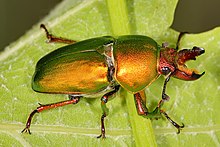
Beetles are insects that form the order Coleoptera, in the superorder Endopterygota. Their front pair of wings are hardened into wing-cases, elytra, distinguishing them from most other insects. The Coleoptera, with about 400,000 described species, is the largest of all orders, constituting almost 40% of described insects and 25% of all known animal species; new species are discovered frequently, with estimates suggesting that there are between 0.9 and 2.1 million total species. Found in almost every habitat except the sea and the polar regions, they interact with their ecosystems in several ways: beetles often feed on plants and fungi, break down animal and plant debris, and eat other invertebrates. Some species are serious agricultural pests, such as the Colorado potato beetle, while others such as Coccinellidae eat aphids, scale insects, thrips, and other plant-sucking insects that damage crops.

Lucanus cervus, known as the European stag beetle, or the greater stag beetle, is one of the best-known species of stag beetle in Western Europe, and is the eponymous example of the genus. L. cervus is listed as Near Threatened by the IUCN Red List.
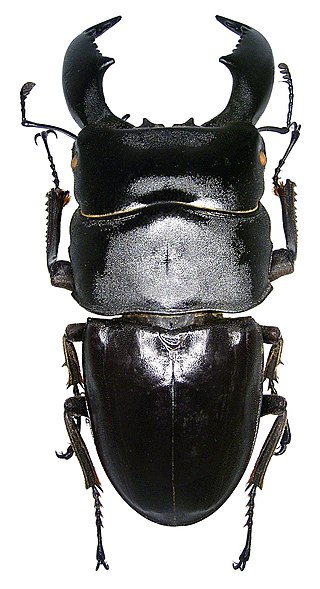
Dorcus titanus is a beetle of the family Lucanidae. It was described by Jean Baptiste Boisduval in 1835. Huang and Chen (2013) separated Serognathus from Dorcus by representing morphological characters and DNA analysis.
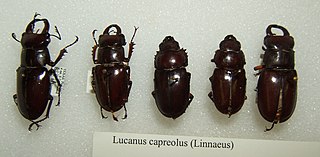
Lucanus capreolus, the reddish-brown stag beetle, is a beetle of the family Lucanidae. The specific name capreolus is derived from Latin, meaning "roe deer". The name refers to the resemblance of the mandibles to deer antlers.

Lucanus elaphus, the giant stag beetle, is a beetle of the family Lucanidae native to eastern North America. They are sometimes kept as pets.

Lucanus formosanus is a stag beetle which is endemic to Taiwan, and grows to a length of 45–80 millimetres (1.8–3.1 in). Like other species in the Lucanid family, L. formosanus exhibits distinct sexual dimorphism and subsequent external morphological allometry in males. Males of the species develop mandibles of various forms depending on geographic location; i.e. northern, central, and southern morphs.

Odontolabis cuvera, the golden stag beetle, is a beetle of the family Lucanidae, stag beetles.

Chiasognathus grantii is a species of stag beetle found in Argentina and Chile. It is known as Darwin's beetle, Grant's stag beetle, or the Chilean stag beetle.

Cyclommatus metallifer is a species of stag beetle in the family Lucanidae. There is sexual dimorphism within the species. Males are generally larger in size and have enlarged mandibles. It is named for its metallic coloration, which ranges in color and may be varying levels of black, brown, or gold. This species is notably easy to maintain, making it a useful species for scientific study. Additionally, it has been kept as an exotic pet.

Cyclommatus is a genus of the family Lucanidae, also known as the stag beetle. The majority of the species from the genus Cyclommatus are located in Southeast Asia, though some species are found in China and Taiwan as well. The genus Cyclommatus also consists of three subgenera: Cyclommatus, Cyclommatinus and Cyclommatellus. Each subgenera contains 80, 24 and 3 species respectively. In total, the genus Cyclommatus consists of a total of 134 species, though more are still being discovered to this day.

Hexarthrius parryi, the fighting giant stag beetle, is a species of large stag beetles. It belongs to the genus Hexarthrius of the tribe Lucanini. It is classified under the subfamily Lucaninae of the stag beetle family Lucanidae.

Lucanus laminifer is a species of beetles of the family Lucanidae.

Paralissotes reticulatus, also called the New Zealand reticulate stag beetle, is a native species of stag beetle from New Zealand. Although they do have wings they are flightless.

Geodorcus helmsi,New Zealand giant stag beetle or Helms's stag beetle is a large, slow-moving, flightless stag beetle in the family Lucanidae. It is endemic to New Zealand.

Dorcus rectus, the little stag beetle, is a species of beetles in the family Lucanidae. It can be found in China(Liaoning), Korea, Japan, Taiwan and Russia. These beetles have a distinctive red shell that separates them from Dorcus curvidens. Males of this species have been observed to have mandible trimorphism, a characteristic that has only been described in two species of Lucanidae—with the other one being Odontolabis cuvera—"and a small number of other invertebrates" as of 2017. The mandibles are used by males as weapons.
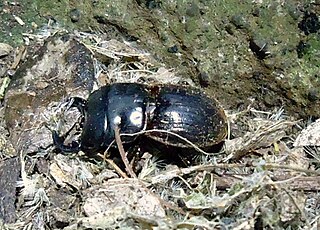
Geodorcus capito is a large flightless species of stag beetle in the family Lucanidae. It is endemic to the Chatham Islands in New Zealand.

Geodorcus alsobius, or Moehau stag beetle, is a large flightless species of stag beetle in the family Lucanidae. It is found only on Mt Moehau, the highest mountain in the Moehau Range on the Coromandel Peninsula in New Zealand.

Geodorcus sororum is a large flightless species of stag beetle in the family Lucanidae. It was discovered in 1973 by Mr. A. Wright on an expedition to Middle Sister Island/Te Awanui, one of The Sisters Islands/Rangitatahi which are part of the Chatham Islands in New Zealand. This holotype specimen is held in the New Zealand Arthropod Collection. It was first described by Beverley Holloway in 2007. The name sororum is translated from Latin to mean "belonging to the sisters".
Lucanus datunensis is a species of stag beetle endemic to the Tatun Mountain of Taiwan's Yangmingshan.It is first discovered in 1984. It is the smallest stag beetle in Taiwan and is an endangered species threatened by recent human activity.
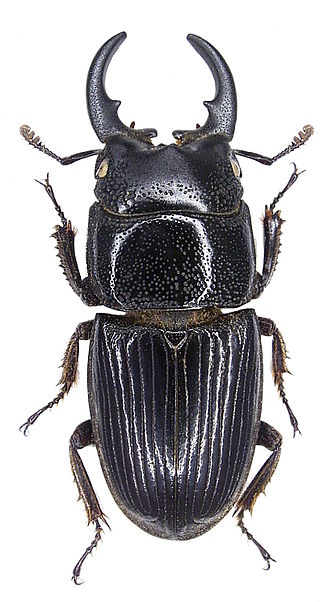
Aegus chelifer, is a species of stag beetle found in Indo-Malaya regional countries.
